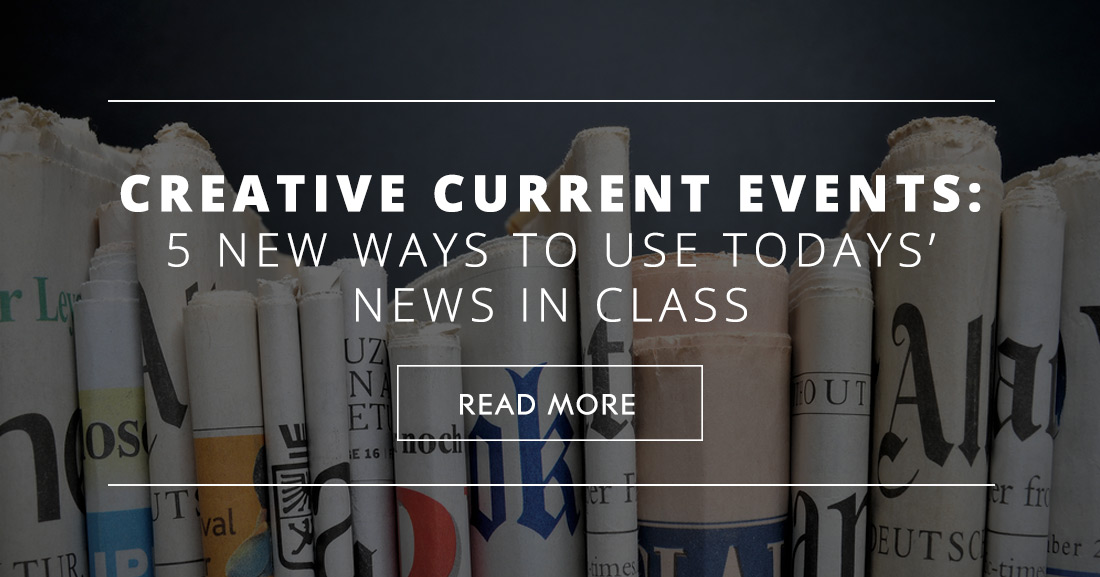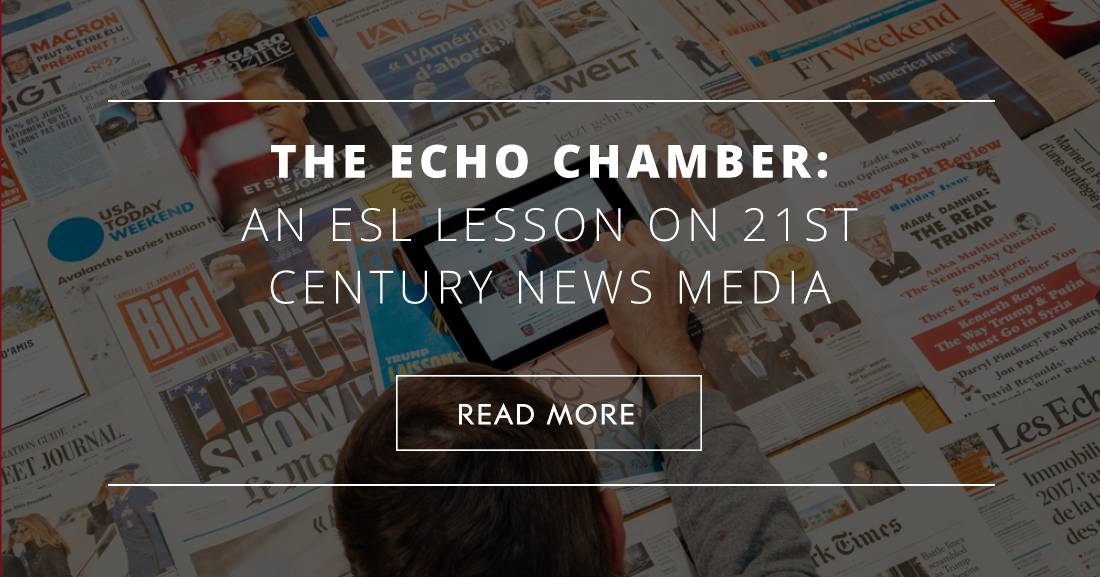Creative Current Events: 5 New Ways to Use Todays’ News in Class


Some will tell you that email and instant messaging have changed the world, others that file-sharing and illegal downloading have reshaped the media industry, and still others that internet commerce has revolutionized business. To this list, I would add one more: the news media.
We consume more news than ever before, but we’re increasingly resorting to non-traditional news sources which bring with them a strange and dangerous phenomenon: the echo chamber effect. This is worth investigating with your students, and they will also provide ready subjects for a quick experiment.
Ask your students where they find their news. If your class is anything like mine, a large majority (65% and more, in our case) relied on Twitter and Facebook for their news, with around 20% of those students admitting that these were their only news sources. Smaller groups favored CNN, the BBC, Al Jazeera and other cable news providers, while one student claimed ‘never’ to pay attention to the news.
We defined the problem: that people tend to seek out and read news sources which confirm the beliefs they already have. For example, if you believe that Europe should accept more migrants from Syria, then you’ll steer clear of pieces which relate migrants and terrorism, because your pre-existing views of migrants rejects such a linkage; essentially, you don’t want to believe those accusations, because they would upset the carefully-built narrative which you already have.
The problem is, once your narrative is confirmed (and repeatedly re-confirmed) the likelihood of your studying other sources which express an opposing view is nearly zero. I asked my students to hone in on this phenomenon and we tried to build up a set of reasons why some people behave in this way. Psychology, social factors and new ideas from Silicon Valley have all played a part, as we’ll see.
Ask your students to picture a newspaper from fifty years ago; better still, bring one in, or show an example from the Internet. They’ll immediately notice huge differences between such cherishably anachronistic institutions and the forms of news media we presently consume:
But above all, my students told me that they were aware of how personalized their news had become. Twitter and Facebook make use of algorithms which track our reading habits and suggest news sources and articles which adhere closely to those same views. I taught the expression confirmation bias, and I asked my students to be honest about this: did they deliberately seek out articles which fact-checked or refuted a given piece, or did they tend to take the piece at face value?
The latter proved generally true, and for reasons I hadn’t suspected. My students told me that their news sources, lacking a traditional news editor, are in fact curated by their friends and family. We found that they were far more likely to read the same news sources as their friends, and that sharing an interesting piece was a common offshoot of agreeing with its subject matter. We analyzed the effects this might have, and we had the following memorable (and genuine) exchange:
| Teacher: | So, what happens if we only read things we already agree with? |
| Student 1: | Umm, we still agree with it? |
| Student 2: | We agree more! |
| Teacher: | But does that really help us understand the world? |
| Student 1: | The world is complicated. |
| Student 3: | Complicated? Is impossible, sometimes! |
| Teacher: | How do you mean? |
| Student 3: | We need help understanding. |
| Student 2: | Especially in English. |
| Student 1: | But I don’t read the news in English. |
| Teacher: | I’d like it if you did, though. |
| Student 1: | Is hard! Because already there’s a… you know, a problem… |
| Teacher: | A barrier? The language barrier? |
| Student 1: | Yeah, a barrier between me and the words. |
| Teacher: | So, figuring out if the article is true or not, that’s another barrier? |
| Student 2: | Many articles are not true. |
| Student 3: | Then read better news! |
| Teacher: | I don’t know if it’s as simple as that. How do we know if we can trust the news we read? |
| Students: | [Silently thinking this through] |
| Teacher: | Is it even possible to know for sure? |
| Student 4: | If my friends trust, maybe I can trust. |
| Student 3: | But maybe your friends are stupid! |
| Student 4: | Huh? |
| Teacher: | You didn’t mean to be rude, right? You just meant his friends might not know what’s true or not, either. |
| Student 4: | My friends are smart! |
| Teacher: | Yes, but everyone makes mistakes. And it’s difficult to know which news source are trustworthy. |
| Student 1: | Maybe we can’t trust anything. |
| Student 3: | But then we’d never read anything! |
| Teacher: | It’s not easy. We have to use critical thinking. |
| Student 4: | But… News is like an entertainment now. Why must always thinking, thinking? Why not relax and just read for fun? |
| Teacher: | Wow, OK. News as entertainment. Get together for a minute [gives usual ‘pairwork time’ gesture] and tell me how you feel about that. |
I hadn’t considered this before we started. What if the search for true and reliable information was coming second, in some people’s minds, to the search for something easy and entertaining to read? My students eventually concluded that news and entertainment could mix, but that this brought huge potential problems; they also felt that news should be entertaining in some way, but that the ‘fun’ should never be prioritized over the ‘truth’.
We focused on the ‘Birther’ scandal as an example of a fake story (that President Obama was not born in Hawaii, but in Kenya or elsewhere) which had gained incredible traction and endured for years. Observers of the media refer to this as ‘belief perseverance’, and it occurs when a story is comprehensively contradicted (in this case, by the production of Obama’s birth certificate) but, contrary to what we might hope or expect, this refutation does little to dull the initial belief. We immediately connected this phenomenon to the alt-right, and to conspiracy theorists who pedal irresponsible rubbish just to enjoy the resulting chaos.
I invited my students to consider the mentality of someone who received hard, concrete evidence which undermines their beliefs, but rejects this and continues to believe as before. We found this, in my students’ words, to be ‘bad science’, and ‘baby thinking’, though some also admitted that they have been guilty of rejecting science which would otherwise wreck a long-held view.
This topic brings up so many potential avenues for further discussion, reading, research and writing. Here are some favorites which I used as in-class research tasks and homework assignments:
After three two-hour classes, my students concluded that the ‘echo chamber’ is real and dangerous, and that only the individual consumer of news could make decisions regarding tone, content, bias and reliability. We characterized political polarization in the United States as stemming in part from a ‘tunnel-vision’ attitude to news, heavily subject to the confirmation bias; my students are concerned that, without refutation or fact-checking, stories of an incendiary, inflammatory and divisive nature will continue to be a feature of our news landscape.